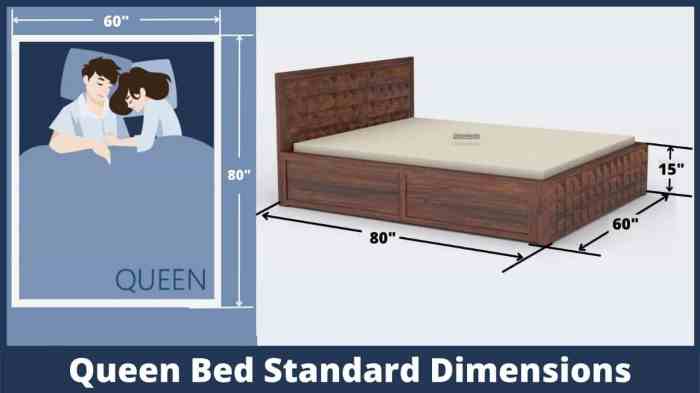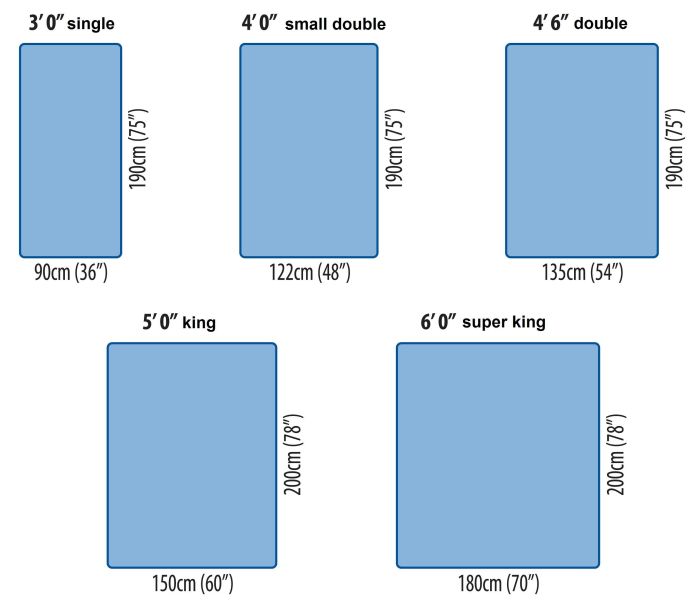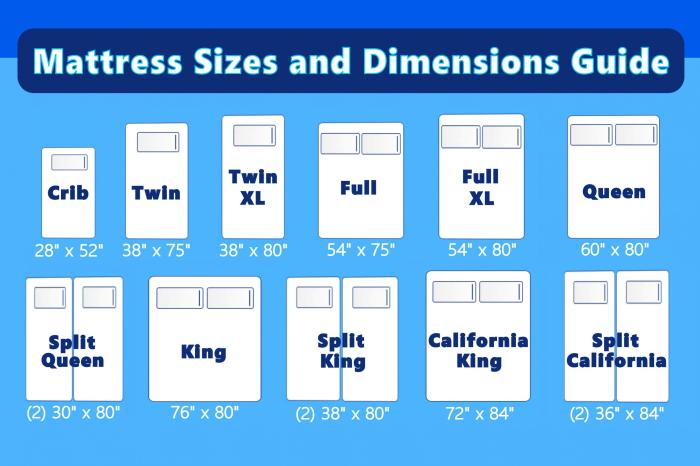Delving into the realm of queen bed dimensions, this guide offers a comprehensive exploration of everything you need to know about these spacious and versatile sleeping havens. From standard measurements to variations and compatibility, we’ll navigate the intricacies of queen beds, empowering you to make informed decisions for a restful and stylish slumber.
Dimensions and Specifications

Queen bed dimensions are standardized to provide ample sleeping space while maximizing room efficiency. The standard measurements for queen beds are 60 inches (152.4 centimeters) in width and 80 inches (203.2 centimeters) in length. These dimensions allow for two adults to sleep comfortably without feeling cramped.
To provide a comprehensive comparison, here is a table showcasing the dimensions of queen beds from different manufacturers:
| Manufacturer | Width (inches) | Length (inches) |
|---|---|---|
| IKEA | 60 | 80 |
| Ashley Furniture | 60 | 80 |
| Serta | 60 | 80 |
| Simmons | 60 | 80 |
Variations and Types

Queen beds come in a variety of styles, each with its own advantages and disadvantages. Consider your personal preferences and the aesthetics of your bedroom when choosing a bed frame.
When it comes to queen bed dimensions, there are standard measurements to consider. However, if you’re looking for a wide selection of queen beds and other bedroom furniture, Harvey Norman is a great place to start your search. They offer a diverse range of styles and sizes to suit every taste and requirement, ensuring you find the perfect fit for your queen-sized bed.
Platform Beds
Platform beds have a simple, modern design that consists of a raised platform supported by legs. They do not require a box spring, making them a budget-friendly option. Platform beds offer a sturdy and stable base for your mattress, and their low profile can create a more spacious feel in the room.
Sleigh Beds, Queen bed dimensions
Sleigh beds are characterized by their curved headboard and footboard, which resemble the shape of a sleigh. They often have intricate carvings or embellishments and can add a touch of elegance to the bedroom. However, sleigh beds can be bulky and may not be suitable for smaller rooms.
Canopy Beds
Canopy beds have a frame that supports a fabric canopy or drapes. They create a cozy and romantic atmosphere in the bedroom. Canopy beds can be made of various materials, such as wood, metal, or fabric, and can be customized to match your decor.
When selecting bedding for a queen-sized bed, its dimensions of 60 inches wide by 80 inches long should be considered. For those seeking a versatile and stylish cover for their sofa bed, the friheten sofa bed cover is a suitable option.
It provides comfort and protection while complementing the queen bed’s measurements.
Mattress Compatibility
Selecting the right mattress for your queen bed is crucial for a comfortable and restful sleep. Various mattress types are compatible with queen beds, each offering unique features to meet different preferences and support needs.
When choosing a mattress, consider factors such as firmness, support, and materials. Firmness levels range from soft to firm, providing varying degrees of cushioning and support. Support refers to the mattress’s ability to distribute weight evenly, reducing pressure points and ensuring proper spinal alignment.
Materials used in mattresses include memory foam, latex, innerspring, and hybrid combinations, each with its distinct properties and benefits.
Types of Mattresses Compatible with Queen Beds
- Memory Foam:Conforms to the body’s shape, providing pressure relief and support. Retains heat, making it suitable for cold sleepers.
- Latex:Naturally hypoallergenic and breathable, offers excellent support and durability. Bounces back quickly, providing a responsive feel.
- Innerspring:Traditional construction with coils providing support and breathability. May not conform as well to the body as foam mattresses.
- Hybrid:Combines different materials, such as foam and innerspring, offering a balance of support, comfort, and breathability.
Bedding and Linens
When selecting bedding and linens for a queen bed, consider the size and shape of the mattress, as well as personal preferences for comfort and style.
Queen bed dimensions are generally around 60 inches wide by 80 inches long, making them a comfortable size for most people. However, if you’re looking for something a little smaller, a dog bed with cover might be a better option.
These beds are typically around 36 inches wide by 24 inches long, so they’re perfect for small dogs or cats. They also come with a variety of covers, so you can find one that matches your home décor. And if you’re worried about your pet making a mess, many dog beds with covers are machine-washable.
Sheets
- Fitted sheets:Designed to fit snugly over the mattress, these sheets have elastic around the edges to prevent slipping.
- Flat sheets:Larger than the mattress, these sheets are placed over the fitted sheet and tucked in at the sides and foot of the bed.
- Top sheets:Optional layer placed over the flat sheet, adding warmth and style.
Blankets
Blankets provide warmth and comfort during sleep. Choose from various materials, such as:
- Cotton:Breathable and moisture-wicking, suitable for all seasons.
- Flannel:Soft and warm, ideal for cold weather.
- Microfiber:Soft, lightweight, and hypoallergenic.
Pillows
Pillows support the head and neck, contributing to comfort and sleep quality. Select pillows based on:
- Size:Standard or queen-size pillows are typically used for queen beds.
- Fill:Down, feathers, memory foam, or synthetic materials provide varying levels of support and comfort.
- Firmness:Choose pillows that provide adequate support while maintaining comfort.
Space Considerations

Determining whether a queen bed will fit in a particular space requires careful measurements and planning. Here are some guidelines to help you assess the space requirements and maximize space utilization:
To determine if a queen bed will fit in a specific space, measure the dimensions of the room and the bed itself. Ensure there is at least 30 inches of clearance on all sides of the bed for comfortable movement and access.
Consider the placement of doors, windows, and other furniture to ensure the bed does not obstruct any pathways or create a cramped feeling.
Arranging Furniture and Other Items
To optimize space around a queen bed, consider the following tips:
- Choose furniture with a low profile to avoid visually cluttering the space. Opt for pieces with clean lines and open designs that allow for visual flow.
- Maximize vertical space by using shelves, wall-mounted storage, and hanging organizers to store items off the floor.
- Incorporate multi-purpose furniture, such as a bed with built-in storage drawers or a headboard with shelves, to save space and keep belongings organized.
- Utilize the space under the bed by storing seasonal items, bulky blankets, or rarely used items in under-bed storage containers.
Closure: Queen Bed Dimensions
Whether you’re furnishing a cozy retreat or maximizing space in a compact abode, understanding queen bed dimensions is essential. This guide has equipped you with the knowledge to select the perfect bed frame, mattress, and linens, ensuring a blissful night’s sleep every time you lay your head down.
Commonly Asked Questions
What are the standard queen bed dimensions?
In the United States, standard queen bed dimensions measure 60 inches in width and 80 inches in length (152.4 cm x 203.2 cm).
What types of queen beds are available?
Queen beds come in various styles, including platform beds, sleigh beds, canopy beds, and more. Each type offers unique advantages and aesthetics to suit different preferences.
How do I choose the right mattress for a queen bed?
Consider factors such as firmness, support, and materials when selecting a mattress for your queen bed. Your personal preferences and sleep habits should guide your decision.